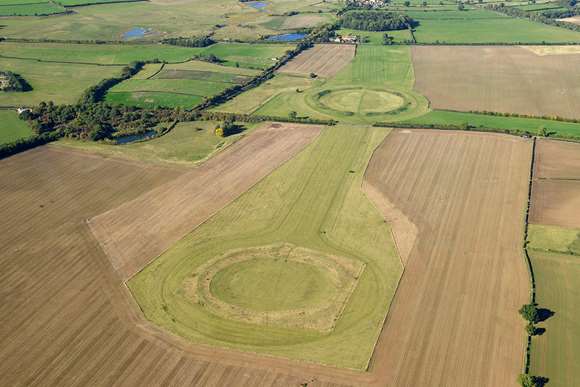Historic England and English Heritage have secured the future of two massive henge monuments and their surrounding landscape, part of a Neolithic complex in North Yorkshire described as “the Stonehenge of the North”. The henges will join Stonehenge, Iron Bridge, Dover Castle, Kenwood and numerous Roman sites on Hadrian’s Wall within the National Heritage Collection. From today, we will be welcoming the public to the henges and sharing the site’s stories with visitors.
The Thornborough Henges complex, near Ripon, is an extremely important site, consisting of three giant, circular earthworks (known as ‘henges’) each more than 200m in diameter. Dating from 3500 to 2500 BC, the henges are of outstanding national significance. The earthworks are thought to have been part of a ‘ritual landscape’, comparable with Salisbury Plain in south-west England, and are probably the most important single ancient site between Stonehenge and the Orkney Islands in Scotland.
Now, the central and southern henges have been gifted by sustainable building materials and construction solutions business, Tarmac, into the legal ownership of Historic England, the government’s heritage advisor, as part of the National Heritage Collection and are managed by English Heritage. Lightwater Holdings, a local construction materials provider, house builder and leisure group, has also gifted parts of the wider monument to Historic England.
The henges are now under the care of English Heritage and are free to visit. As part of our interpretation programme, we will share with visitors Thornborough Henges’ stories and explain its significance.
Although the henges have remained remarkably well preserved over thousands of years, the central and southern henges were added to Historic England’s Heritage at Risk Register in 2009 due to historic erosion caused by livestock and rabbits. Historic England has been working with landowners Tarmac for a number of years to secure the future of Thornborough Henges, so that they can be enjoyed now and protected for future generations. The donation of the henges to the nation is the best option to secure the monuments’ long-term future and will lead to it being removed from the Heritage at Risk register.
Duncan Wilson, Historic England’s Chief Executive, said: “Thornborough Henges and their surrounding landscape form part of the most important concentration of Neolithic monuments in the North of England. They are a link to our ancient ancestors, through thousands of years, inspiring a sense of wonder and mystery. We are thrilled to have acquired this highly significant site for the nation, ensuring that these magnificent monuments are safe and will be preserved for generations to come.”







